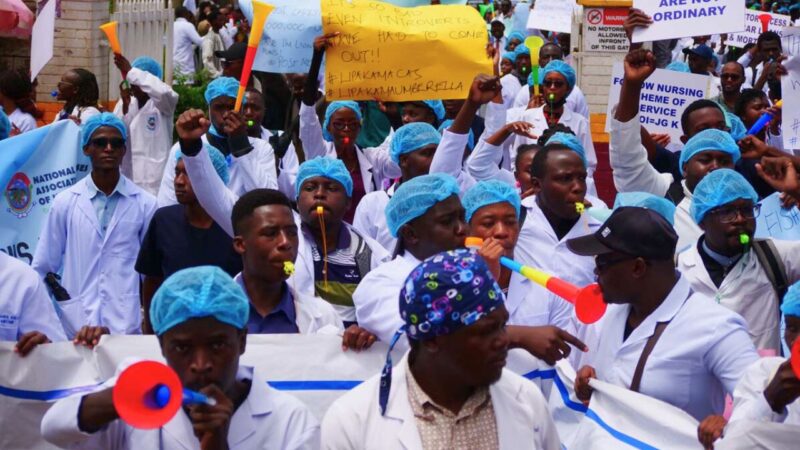Private consensual sexual conduct between adults of the same sex is criminalised in Kenya and 32 other African countries. How did private consensual sexual conduct between adults become the subject of criminal laws in Kenya and most of these African countries? How does the secrecy surrounding matters related to sex and sexuality influence the implementation of these laws? Let’s take a journey through Kenya.
According to legal historians, what is today known as Kenya started off as the British East Africa Protectorate in 1896. The protectorate was ruled under British law; prior to that period, no formal legal structure existed. Further, the name Kenya did not exist until it was named so as a colony in 1920 and as a country in 1963 (upon independence). Criminalisation of same sex relations in Kenya dates back to between 1897 and 1902, when the British colonial authorities applied the Indian Penal Code that had been drafted by the British and which criminalised same sex relations. The Indian Penal Code was a novel colonisation project aimed at using legislation to model British values and common law to govern British protectorates and colonies abroad.
Research by Dr. Nancy Baraza characterises the history and rationale of the criminalisation of homosexuality as part of the disguise to civilize “natives”, stop slavery and spread Christianity. She found that it led to social coercion into British moral and Christian religious values whose aim was to standardise divergent ethnic sexualities for ease of ruling and colonising them. Dr. Baraza found that these colonial laws that policed sexuality and gender were closely tied to Judeo-Christian religious beliefs that gradually displaced African customary laws that recognised the harmony of gender, sexuality and spirituality.
Upon Kenya’s independence in 1963, the pre-colonial Penal Code was adopted by the post-colonial state without substantive changes, save for the renamed title of the statute to reflect promulgation by the newly created sovereign Parliament of Kenya. Kenya, therefore, remained among those African countries that mete varying punishments for same sex relations. The death penalty is imposed for homosexual sex in Sudan, Nigeria (12 northern states), Somalia and Mauritania. Life sentences are prescribed by penal law in Tanzania, Uganda and Sierra Leone. Kenya imposes a fourteen-year imprisonment term. To prove the crime of homosexual sex, forced anal examinations are used to in Tanzania, Cameroon, Egypt, Tunisia and Uganda. (Kenya’s Court of Appeal banned the practice in 2018.) Attempts to commit homosexual sex are also punished in Kenya, including indecent acts between males. The crime of homosexual sex is framed as an “unnatural” offence, carnal knowledge against the order of nature, or indecent acts between adults.
The legal challenges
The African Commission on Human and Peoples Rights (ACHPR) has noted that individuals in Africa continue to face infractions due to real or imputed sexual orientation and/or gender identity. According to the ACHPR, common infractions include “corrective” rape, physical assaults, torture, murder, arbitrary arrests, detentions, extrajudicial killings and executions, forced disappearances, extortion and blackmail. In a 2014 resolution against violence on ground of sexual orientation or gender identity in Africa (resolution 275), the African Commission called on African states to take preventative actions and redress these violations, including through legal reform.
This history of an imposed legal system in relation to criminalisation of same sex conduct in Kenya was slightly altered through Act No 5 of 2003 when section 162 of the penal code was amended to remove corporal punishment, which had existed as a supplementary punishment to the prison sentence of fourteen years for homosexual sex. This amendment also distinguished punishment for consensual unnatural offences (14 years) and non-consensual (sodomy) unnatural offences (21 years). Removal of corporal punishment for unnatural offences was part of general penal reforms to align Kenya’s laws to international obligations against torture and cruel, degrading or inhumane treatment and punishment.
The African Commission on Human and Peoples Rights (ACHPR) has noted that individuals in Africa continue to face infractions due to real or imputed sexual orientation and/or gender identity. According to the ACHPR, common infractions include “corrective” rape, physical assaults, torture, murder, arbitrary arrests, detentions, extrajudicial killings and executions, forced disappearances, extortion and blackmail.
By the time the nation was debating a new constitution, discrimination on the basis of sexual orientation was being discussed inconclusively by constituent assemblies, including at the subsequent 2010 referendum. The new 2010 Constitution entrenches an elaborate Bills of Rights that affords constitutional protection from discrimination. Article 27 states: “The State shall not discriminate directly or indirectly against any person on any ground, including race, sex, pregnancy, marital status, health status, ethnic or social origin, colour, age, disability, religion, conscience, belief, culture, dress, language or birth.” While being inclusive, Article 27 does not explicitly list sexual orientation or gender identity. On the contrary, the Constitution recognises only heterosexual unions in Article 45, which states that “every adult has the right to marry a person of the opposite sex, based on the free consent of the parties”.
In addition, Section 158 of the Children’s Act of Kenya explicitly prohibits adoption of children by homosexuals, In brief, Kenya’s legal system is generally hostile to gays, lesbians, bisexuals and queer persons. The law is also vague on the constitutional protection from discrimination on the basis of sexual orientation and gender identity. There is no comprehensive or specific equality legislation to guarantee protection from sexual orientation and gender identity discrimination, particularly in employment, health, housing and other social economic spheres.
In 2012, a Kenya National Commission on Human Rights (KNCHR) report on sexual and reproductive health rights in Kenya recommended decriminalisation of same sex relations. This was in order to ensure the realisation of the right to the highest attainable standard of health, including reproductive healthcare, as enshrined in article 43 of the Constitution 2010.
Studies have shown that gay men suffer discrimination when they access health services in Kenya and taboos around homosexuality prevent many others from seeking health services. Similar findings on the effects of criminalisation on state health policies and recommendations on their decriminalisation have been made by the Kenyan Ministry of Health in its HIV and AIDS Strategic Plan (2009/10-2012/13 as well as the 2014-2019). The justification of the health ministry and the KNCHR is that decriminalisation will remove structural barriers that impede access to the provision of the highest attainable standard of health care to all, which is a constitutional right in Kenya. KNCHR and the ministry have been consistent every year on their recommendations on decriminalising homosexuality, including through supporting civil society and individuals working on this reform issue. These empirical findings and recommendations by the health and the state human rights institution stand in contrast with active prosecutions against suspected homosexuals in Kenya by the police and the Director of Public Prosecutions.
Religion and politics
The most common rhetoric against same sex relations in Kenya has been coming from the religious and political elite who often characterise homosexuality as being against African tradition and biblical teachings. Studies have found that this charge of homosexuality being exogenous to Africa is politically designed to erode the legitimacy of same sex sexualities in Africa and to assert a homogenous “cultural identity”. This makes the public dependent upon political and religious leaders for “a communal sense of self”. It reminds the public what the government is – that it is in charge, in power and working or aspires to work for their best interests and survival, including protecting the most vulnerable (especially children) from “recruitment” and securing the future of the nation (by securing reproduction). The law under study therefore becomes political bait, an attractive instrument to regenerate political power domestically and internationally. This is made possible when arguments intersect with popular religious doctrine and social anxieties over reproduction, marriage and the future.
The most common rhetoric against same sex relations in Kenya has been coming from the religious and political elite who often characterise homosexuality as being against African tradition and biblical teachings. Studies have found that this charge of homosexuality being exogenous to Africa is politically designed to erode the legitimacy of same sex sexualities in Africa and to assert a homogenous “cultural identity”.
The public discourse becomes more difficult when homosexuality is politicised with religious doctrines whose nature hardly allows deliberations, which are necessary for democratic progress. This politicisation of religion is conflated with social anxieties over reproduction and social security.
Studies have found that economic inequalities give such political rhetoric traction. In this power analysis of law, the inflation of claims (such as saving the morality of the country) work to displace desires and failures within society and fix them on minority human objects who are generalised and whose presence or distinguishing factor (such as sexual orientation, in this case) is not distinctive or new to Kenya.
We are a developing country that is struggling with poverty and a high population growth rate. Poverty, religious doctrine that does not allow reasoning or deliberations, and an education system whose compulsory curriculum teaches homosexuality to be a moral/social deviance can be seen as part of the key social economic factors involved in shaping the public posture against homosexuality.
A convenient distraction
Activists have argued that the political capital invested by the Kenyan state on homophobia is a tactic to distract the public from pressing economic issues, such as rampant corruption. Studies show that after the end of colonialism, arbitrary governments in most post-colonial African states “latched onto anti-homosexuality laws as ammunition in a battle for power”. Such political rhetoric has also been found to thrive more in countries with weak institutions, inadequate basic equality statutes, poor participatory rights and social protection law, increasing inequalities, high unemployment amongst youth, and a general restrictive civic space. Studies have also established that compared to full democracies, authoritarian regimes and flawed democracies have a higher propensity to criminalise homosexuality
There are findings that support the need for reform on this issue. Research by the World Bank shows that a country’s economic growth is inversely correlated with the level of discrimination against ethnic, religious and sexual minorities under the law. The study found that criminalisation of homosexuality is connected with economic development with multiple links and that criminalisation costs as much as 1.7 per cent of a country’s GDP. Other studies have argued that criminalisation of homosexuality is “irreconcilable with good governance” because it hinders progress within a country, particularly in regard to democracy, the rule of law, human rights, public health, and economic development
The economic benefits of ending discrimination using the rule of law, therefore, resonate with many aspirations of middle- and low-income African countries. Continued discrimination against sexual and gender minorities through law is a grave economic concern in emerging African economies such as Kenya, which is currently working to achieve inclusive development.
In the social-cultural sphere, Kenya’s creative/arts scene has increasingly become a mirror of the diversity in Kenya’s gender and sexuality fluidity. Notable among them are the films Stories of Our Lives and Rafiki, whose same sex themes have been banned locally but have spiked local and international demand. Art galleries and cultural centres in Kenya have in recent years been hosting Lesbian Gay Bisexual Trans Intersex and Queer (LGBTIQ) art and cultural events without state sanction. Reputed artists, such as Michael Soi, with his provocative paintings on sexuality and Kawira Mwirichia, with her Kanga love art, also continue to highlight the changing social landscape on matters sexuality and gender in Kenya. Although the education curriculum in primary and secondary schools still teaches that homosexuality is a social deviance, many public universities and colleges have been pushing back with a much more inclusive curriculum, especially in law schools. In addition, student-led bodies in universities and colleges have been engaging in research, internships, moot courts and other public service partnerships with civil society organisations dealing with LGBTIQ equality in Kenya.
Enforcement of gay laws
The existing laws against homosexual offences are actively enforced in Kenya. In 2015, a “Ministerial statement on non-enforcement of anti-gay laws in Kenya” indicated that between 2010 and 2014, the Kenya Police had prosecuted 595 cases of homosexuality across Kenya. An independent due diligence report of this police report found gross errors and conflation of homosexuality with bestiality and defilement charges. The conflation was either deliberate or was meant to increase social opprobrium towards homosexuality (by conflating consensual private adult same sex intimacy with bestiality and defilement). It could also be due to mistakes due to poor record-keeping by the police whose documentation remains largely manual.
The existing laws against homosexual offences are actively enforced in Kenya. In 2015, a “Ministerial statement on non-enforcement of anti-gay laws in Kenya” indicated that between 2010 and 2014, the Kenya Police had prosecuted 595 cases of homosexuality across Kenya. An independent due diligence report of this police report found gross errors and conflation of homosexuality with bestiality and defilement charges.
In addition, civil society organisations continue to document human rights violations based on sexual orientation and gender identity. In 2010, the Kenya Human Rights Commission (KHRC) found that LGBTIQ persons in Kenya are routinely harassed by police, evicted from housing by landlords, fired from jobs, denied access to healthcare and cut off from families, religious groups and social support structures. The National Gay and Lesbian Human Rights Commission (NGLHRC) has since 2012 been responding to and documenting violations against LGBTIQ persons. Annual legal aid reports from NGLHRC indicate that recurrent violations include “corrective” rape, physical assaults, arbitrary arrests, detentions, extrajudicial killings and executions, forced disappearances, extortion and blackmail, entrapment, among others. NGLHRC has been litigating on some of these violations, including challenging the use of forced anal examination to prove sexual orientation, forced evictions by landlords, dismissals from work, denial of government services and documents, etc.
Interpreting anti-homosexuality laws
Be that as it may, Kenya’s judicial jurisprudence on this issue demonstrates a compelling state interest to extinguish legal discrimination on the basis of sexual orientation and gender identity that is often justified and excused by the existence of criminal sanctions against LGBTQ persons. In Petition 440/2013 that sought to register the National Gay and Lesbian Human Rights Commission with the NGO Board, Justices Lenaola Odunga and Mumbi Ngugi ruled unanimously that sexual orientation was constitutionally protected from discrimination in Kenya and allowed the registration of the NGO. In February 2018, the Court of Appeal struck down the use of anal examination to prove homosexual orientation after the NGLHRC challenged anal examination, which had been performed on two suspected gay men at the Coast General Hospital. In the Baby A case, the court found that intersex persons in Kenya have the right to be recognised as persons before the law and went further to task the relevant state organs to develop relevant policy to secure recognition of intersex persons as persons before the law.
Courts in Kenya have also allowed the registration of transgender groups and the change of gender markers on official documents issued by the government to transgender persons. The first stream is an internal analysis of the legal system using Kenyan law jurisprudence from which finds that there is arbitrary interpretation and application of the criminal rule under study which is inconsistent with the rule of law. The courts have become aware of this inconsistency and framed it as a constitutional issue, thereby triggering public discourse. The second stream is external in that it makes observations “outside” of the law on the performance of this criminal rule and characterises the performance of this law as political instrumentalisation of arbitrariness. This arbitrariness is more instrumentalised by the democratic branch of government through inflated paternalistic moral and religious claims within the domestic and international public spheres. I conclude by predicting how the criminal rule under study is under imminent foreclosure through court action under a rule of law analysis.
Moving towards a less homophobic society
I predict that criminalisation of homosexuality will grow into an exceptional doctrine in criminal law and will incrementally be foreclosed by courts as erroneous and excluded within the general domain of law. Criminal law is meant to prevent harm to society and enhance harmony and order within persons. To achieve order, the law can regulate how humans relate by way of justifiable legal stipulations and legal constrains. Over time, equality and non-discrimination will become the dominant theories in the transformation of the law in Kenya, but the foreclosure of the criminalisation described in this essay is a necessary first step.
Claims against the negative effects of criminalisation of homosexual conduct will continue to sharpen the consciousness of the courts on the structure, meaning and effects of this law. The claims will allow the courts to be the public repository of accounts of discrimination on the basis of sexual orientation. The critical studies movement has taught us that we can reform our legal practice to deliver legal justice without breaking legality. This reformed legality supports the foreclosure of criminalisation with the aim of protecting the constitutional/immunity rights of persons affected by this law because these rights already exist in our constitutional texts.
The ongoing litigation work by LGBTIQ individuals are therefore democratic efforts by citizens and organised groups to instill the rule of law, human rights and good governance in Kenya. Such efforts fulfill the civic duty that individuals and social movements have in promoting the democratic values of their communities and the country through institutional enforcement of their rights in courts. It is also a follow-up from constitutional drafting conferences that appreciated the issue as contentious but offered no closure to the affected. Individuals and social movements are using the judiciary to communicate and document their discriminatory lived experiences. By framing these claims as constitutional breaches, individuals are building public value of human rights as an essential part of their democracy and societal values. Courts therefore become entry points of building human rights and democratic values into social and political pillars of society.
Claims against the negative effects of criminalisation of homosexual conduct will continue to sharpen the consciousness of the courts on the structure, meaning and effects of this law. The claims will allow the courts to be the public repository of accounts of discrimination on the basis of sexual orientation.
The fact that these cases are being entertained, processed and resolved without dismissals due to technicalities and despite the fact that there are existing laws that criminalise homosexuality are green shoots and omens that suggest that access to justice is being realised in Kenya, which is a score for our democracy. It shows that the courts in Kenya are rooting for the rule of law and the constitutional constraints in the law’s predictability.
Because the Constitution of Kenya 2010 was promulgated through a public referendum, courts enjoy sole curatorship of the Constitution, arguably raising the public acceptance of their decisions and the democratic pedigree of their legitimacy. Their decisions, therefore, play a leading role in public discourse.
Foreclosure through decriminalisation will, however, need enforcement. This might translate to a reduction of arrests and prosecutions of suspected homosexuals as well as reduced social and economic exclusion. It is possible that LGBTIQ persons have begun to value their constitutional rights and will take more chances for equal protection within the civic commons. It is also possible that sexuality, citizenship and belonging will remain a live constitutional issue for judges in Kenya for the next decade as the cases move to the appellate stages through the courts.
Regardless of the outcome of these cases, Kenya’s legal consciousness on how continued criminalisation of homosexuality undermines our constitutional principles and goals has already been established by courts, individuals, movements, state human rights organs and government health agencies. By litigating towards decriminalisation of homosexuality, activists are implementing evidence-based recommendations of state agencies as well as upholding the constitutional promise of non-discrimination, including equal benefit and equal protection under the law. The day may finally come when homosexuality in Kenya will truly be a “non-issue”, as President Uhuru Kenyatta recently stated in a televised interview.








